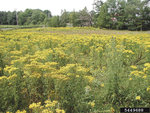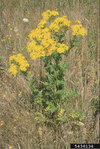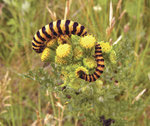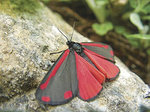



A field of tansy ragwort in full bloom can appear innocent enough, but Clark County officials are rightfully quick to remind area residents of the dangers the noxious weed can present if left to grow freely.
“It’s primarily because of its toxicity towards livestock and horses and we do have a lot of properties in the county that do have horses,’’ said Kevin Tyler, environmental permitting coordinator with Clark County’s Department of Environmental Services.
Because of this past winter’s mild weather, the tansy ragwort is blooming early this summer, which means it’s time for area homeowners to address the issue now that June has arrived.
“Normally, we would see it a little bit later in the year, but this is an exceptionally dryer year so we are seeing it starting to flower at a time of the year when everything is already hopping for us so our workload for this particular summer is higher than normal,’’ Tyler said.
Thanks to the efforts of area residents and Clark County Environmental Services, the tansy ragwort problem has not been on the decline in the area according to Tyler.
“It’s not getting worse,’’ said Tyler, who also indicated he is not aware of any issues with the hay supply in the area.
Why control noxious weeds in Clark County?
Noxious weeds are non-native plants that can be toxic, destructive, competitive and difficult to control once established.
• Economics – Noxious weeds cost the United States on average $30.6 billion each year in decreased land value, money and time spent in control efforts, lower crop yields, reduced forage quality and impacts on animal health.
• Environmental health – Noxious weeds displace native species, destroy natural habitat, clog waterways and increase erosion and fire risk.
• Human & animal health – Many noxious weeds are toxic to humans and livestock. Contact or ingestion of some species can lead to serious health problems or death.
• Recreation – Noxious weeds hurt recreation opportunities such as bird watching and fishing through reduced accessibility and destruction of native landscapes.
Managing weeds with Integrated Weed Management
The most effective way to manage weed infestations is to use a combination of control methods specific to the problem weed, where it is in its growth cycle, and the location where it is growing. This approach is called Integrated Weed Management (IWM), which uses biological, mechanical, cultural and chemical (herbicide) control methods that treat the problem weed yet protect human health, habitat, water and other natural resources.
Prevention is better than control. The best control method of all is to prevent weeds in the first place. IWM starts with understanding the soil, water, natural resources and human impacts and uses on a site. For example, weeds often invade due to overgrazing, bare soil, or other factors that should be corrected for the control measures to be fully effective.
A good IWM plan is more effective than complete reliance on herbicide management. While not all control methods are useful for all weed species, taking an integrated approach to weed management can greatly increase the effectiveness of the efforts. As weed control is not a one-time fix, an IWM strategy should be practical, adaptable, cost-efficient and effective.
Tansy ragwort
Tansy ragwort is an invasive, toxic weed. When prevalent, tansy ragwort is of the most common causes of poisoning cattle and horses, caused by consumption of the weed found in pasture, hay or silage. Milk produced by affected cows and goats can contain toxins.
Stock does not reject or avoid it in hay or silage and its poisonous alkaloids are unaffected by drying. Honey from tansy ragwort also contains the alkaloids. The highest risk is after the plants have been cut or when mixed in with hay, because the plants are not as bitter but just as toxic.
Tansy ragwort is a tap rooted biennial and sometimes a perennial herb growing up to four feet tall. It produces flowerheads that are flat topped clusters. Flowerheads are yellow with many disk flowers and 13 ray flowers. Overall, flowerheads have a daisy-like appearance and bloom June to August.
Tansy ragwort spends the first year in the rosette stage with dark green basal leaves that appear ruffled. The leaf underside is somewhat hairy, and appears whitish. During the second year, one or several flowering stems bolt. The leaves found on the flowering stem are alternate and sessile.
Tansy ragwort is found on roadsides, in pastures, fields and cleared forested areas. Tansy ragwort usually reproduces by seed, although, it can also reproduce vegetatively. A single large plant may produce 150,000 seeds, which can lie dormant in the soil for as long as 15 years.
IWM control recommendations
Types of IWM control methods for tansy ragwort include:
• Physical & mechanical – Methods include digging (good success for small/backyard sites), hand-pulling (good success for small/backyard sites), mowing (poor success for both small/backyard sites and large/rural sites) and tilling.
• Cultural – Methods include bark mulch (fair success for small/backyard sites and poor success for large/rural sites), black plastic (good success for small/backyard sites), cover crop (fair success for small/backyard sites and poor success for large/rural sites), native plant restoration (poor success for both small/backyard sites and large/rural sites) and soil amendment (poor success for both small/backyard sites and large/rural sites).
• Biological – Methods include managed grazing and weed-feeding insects (good success for both small/backyard sites and large/rural sites).
• Chemical (with product examples) – Control methods include aminopyralid (Milestone), glyphosate (Roundup, AquaNeat, Rodeo), triclopyr (Garlon 3A, Lilly Miller Brush Killer). Chemical methods have produced good results for both small/backyard sites and large/rural sites.
It’s important for area residents to understand that controlling noxious weeds on your property is your responsibility and the law (Chapter 17.10 RCW, County Code Title 7). To help the spread of noxious weeds
• Report infestations
• Actively control noxious weeds on your property
• Contact Clark County’s Vegetation Management Program for more information on species ID and recommended control methods
• Spread the word about noxious weeds, and why controlling them is so important.
For more information, call Clark County Environmental Services Vegetation Management Program, (360) 397-6140, or email weed.management@clark.wa.gov, or visit www.clark.wa.gov/environment and www.clark.wa.gov/weed.